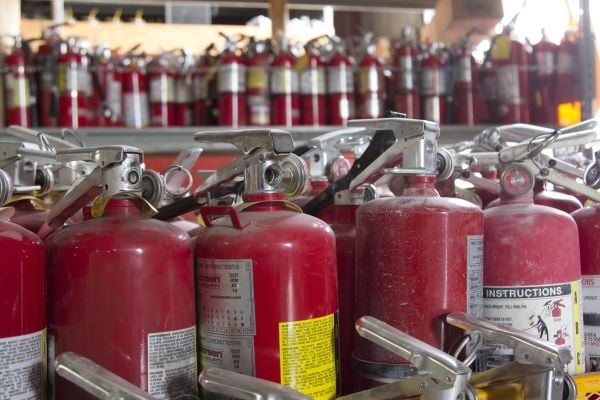
Having and properly maintaining portable ABC fire extinguishers is an important part of ensuring the safety of both your staff and your property.
However, to ensure that your extinguishers are ready when you need them most, it is vital that you understand when they need to be replaced and what to do with them when they do.
Below, find answers to all your questions regarding any old fire extinguishers you may have, including how to know when you can recharge the fire extinguisher, when extinguishers need to be replaced, and how to dispose of fire extinguishers properly.
Fire Extinguisher Lifespan
Portable fire extinguishers generally have an initial lifespan of 12 years.
However, it is important to recognize the difference between rechargeable extinguishers versus disposable ones. While your rechargeable extinguisher may be in good condition to recharge and use for years to come, a disposable extinguisher must be replaced once it reaches this age.
When to Recharge a Fire Extinguisher
So, if you have a rechargeable extinguisher, how do you know whether or not you can recharge it rather than dispose of it?
First, all fire extinguishers require an annual external examination. During this examination, a fire extinguisher technician will examine the condition of the extinguisher and its parts. They will also break the old tamper indicators and replace them with new ones. Finally, the technician will update the tags to show that the extinguisher has received its annual examination.
When ABC fire extinguishers reach their 6th year, they are also examined internally for defects, pitting, and rusting. Once the extinguisher reaches 12 years old, it will need to be inspected for any damages and wear and receive hydrostatic testing to determine if the cylinder is still strong enough to safely contain the pressurized contents. The annual inspections and testing can only be carried out by a fire safety professional, such as Koorsen Fire & Security.
Assuming there are no visible damages to the exterior elements of the fire extinguisher, such as to the nozzle or handle, then it can receive a hydrostatic test. The cylinder must be able to withstand and hold pressure up to 600 psi to pass.
Even if the cylinder appears undamaged and the pressure gauge still reads the appropriate amount of pressure, your 12 -year-old extinguisher will need to undergo this process to ensure it is in proper working order.
If it passes the inspection and tests, your Koorsen technician can recharge it and return it to you for more years of effective use.
When to Dispose of a Fire Extinguisher
As stated above, if you have a disposable extinguisher that reaches 12 years, you will need to dispose of it and replace it.
But even if you do have a rechargeable fire extinguisher, there are times when it cannot be recharged and simply needs to be replaced. The following are some of the reasons:
- The cylinder has been dented or damaged in some way
- Rust has developed around the cylinder or handle elements
- The nozzle is cracked or clogged
- The handle is broken or wobbly
- The inspection tag is missing
- Unexplained pressure loss
- Broken or missing pin
- Failure of the hydrostatic test (unable to withstand up to 600psi of pressure)
Some of these issues may be resolved if you happen to have spare parts (for instance, spare pins), but by and large, the above are legitimate reasons why it may be time to dispose of your old extinguisher and replace it.
If you’re not sure whether the damages you observe or the age of your fire extinguisher necessitates throwing it out, call Koorsen Fire and Security. One of their highly trained technicians will be able to inspect and test it for you to determine whether it just needs maintenance or needs to be replaced.
If your fire extinguisher can be and needs to be recharged, they can perform that for you, or if it needs to be disposed of, they can do so appropriately, safely and provide a replacement.
How to Properly Dispose of a Fire Extinguisher
If you determine that your fire extinguisher needs to be disposed of, remember that they are a hazardous material due to the pressure contained within the canister. They are potentially dangerous and must be disposed of properly.
For fully or partially charged extinguishers, you can dispose of it properly by:
- Allowing Koorsen to do it for you
- Calling your local fire department to see if they accept expired extinguishers
- Finding a hazardous waste dump facility
For empty fire extinguishers, since they are no longer pressurized or contain dangerous chemicals, you can:
- Allow Koorsen to take it for you
- Do it yourself by:
- By pressing the handle to ensure that all remaining pressure is fully released
- Removing the extinguisher valve, so it is clear that the cylinder is empty
- Finding a local recycling facility that will accept the steel shell
Please note that requirements vary from state to state and jurisdiction to jurisdiction. If you choose to throw away or recycle your extinguisher yourself, do your due diligence.
Contact a Koorsen Technician Today
If you’re not sure what condition your fire extinguisher is really in, or if you have some that you know need to be recharged, call Koorsen today. Their expertly trained technicians will evaluate your fire extinguisher and can provide whatever maintenance and care it may need to be in good working order.



